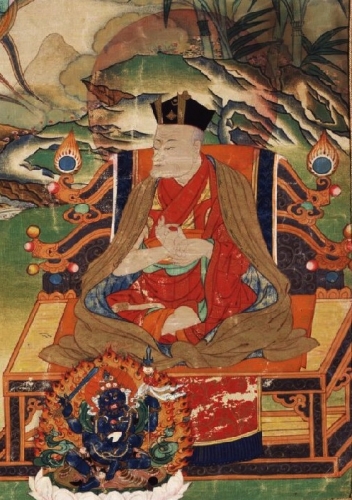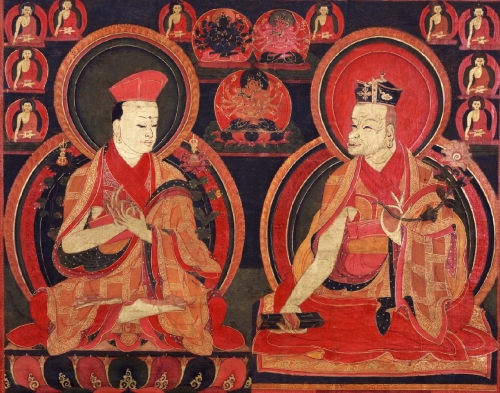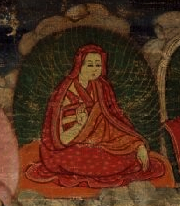Biography and autobiography in Tibet are important sources for both education and inspiration. Tibetans have kept such meticulous records of their teachers that thousands of names are known and discussed in a wide range of biographical material. All these names, all these lives—it can be a little overwhelming. The authors involved in the Treasury of Lives are currently mining the primary sources to provide English-language biographies of every known religious teacher from Tibet and the Himalaya, all of which are organized for easy searching and browsing. Every Tuesday on the Tricycle blog, we will highlight and reflect on important, interesting, eccentric, surprising and beautiful stories found within this rich literary tradition.
Part 1: Mila and Marpa
Part 2: Gampopa and Barompa
Kagyu Founders Part 3: First Karmapa and Lama Zhang
The Kagyu tradition that began in Tibet with Marpa (1012-1097) and his disciple Milarepa (1040-1123) split into multiple traditions instituted by the disciples of Milarepa’s chief student Gampopa Sonam Rinchen (1079-1153). While some thrived, others were little more than the teaching lineage of a single monastery’s founder, and have since been absorbed into other traditions. Such was the case with the traditions initiated by Dusum Khyenpa (1110-1193), who was later known as the First Karmapa, and Lama Zhang Yudrakpa (1123-1193), who established the important monastery of Tsel Gungtang outside of Lhasa. Whereas Dusum Khyenpa initiated the Karma Kagyu tradition, which now has branches around the world, the Tselpa Kagyu fell into decline following the collapse of the Yuan Dynasty. Its teaching and practice lineages were absorbed into the Nyingma and other Kagyu traditions.
 Dusum Khyenpa was born in Kham and took novice ordination with Kadam monks there at the age of sixteen. If the artistic record is to be believed, he was not a handsome man; almost all depictions of him feature a twisted nose and a serious underbite. According to legend, the year that he took ordination a dakini gave him a hat—maybe deep blue, maybe black—made from the hair of a thousand dakinis. Kagyu historians have offered various explanations as to the nature of this hat, which is said to have been invisible to most people, and of the hats worn by subsequent Karmapa incarnations. The Second, Fifth, and Seventh are all said to have been given the first visible hat, the one used in the famous black hat ceremony for which the Karmapas became known.
Dusum Khyenpa was born in Kham and took novice ordination with Kadam monks there at the age of sixteen. If the artistic record is to be believed, he was not a handsome man; almost all depictions of him feature a twisted nose and a serious underbite. According to legend, the year that he took ordination a dakini gave him a hat—maybe deep blue, maybe black—made from the hair of a thousand dakinis. Kagyu historians have offered various explanations as to the nature of this hat, which is said to have been invisible to most people, and of the hats worn by subsequent Karmapa incarnations. The Second, Fifth, and Seventh are all said to have been given the first visible hat, the one used in the famous black hat ceremony for which the Karmapas became known.
Around the age of twenty Dusum Khyenpa went to U-Tsang where he received full ordination. For ten years he studied with Kadam monks, and then, at the age of thirty, he met Gampopa at Daklha Gampo. Gampopa sent him, in the cotton-cloth garb worn by the early followers of Milarepa, to practice tummo, or heat yoga, for nine months, and to various caves for further meditation. He then returned and studied scripture and doctrine with Gampopa. From Gampopa and his disciples he received the complete transmission of the Kagyu tantric traditions— Mahamudra, Chakrasamvara and Hevajra, the Six Yogas of Naropa—in the monastic context that Gampopa had adopted from the Kadam tradition.
Dusum Khyenpa returned to Kham where he established the monastery of Karma Gon, in 1147. This institution, also known as Karma Densa, or “seat of the Karmapa,” remained an occasional residence of the Karmapa incarnations well into the twentieth century. He later returned to U-Tsang, under the command of Gampopa’s nephew and heir, Gomtsul (1116-1169), to establish monasteries there. In 1189, just three years before his death, in the Tolung Valley, he founded Tsurpu Monastery, which ever since has been the seat of the Karmapa incarnations.
 Karma Kagyu tradition holds that before he passed away Dusum Khyenpa gave a letter to a disciple, Sanggye Rechen Peldrak (1148-1218), detailing the circumstances of his rebirth. That lama’s disciple, Lama Pomdrakpa (1170-1249), identified Karma Pakshi (1204-1283) as Dusum Khyenpa’s reincarnation, thus initiating the Karmapa line of incarnations. This was the one of the first, if not the very beginning of the uniquely Tibetan tulku institution, in which disciples of influential lamas find and train subsequent incarnations. The historical record, however, suggests that it was the Third Karmapa, Rangjung Dorje (1284-1339) who declared himself the second incarnation of Dusum Khyenpa.
Karma Kagyu tradition holds that before he passed away Dusum Khyenpa gave a letter to a disciple, Sanggye Rechen Peldrak (1148-1218), detailing the circumstances of his rebirth. That lama’s disciple, Lama Pomdrakpa (1170-1249), identified Karma Pakshi (1204-1283) as Dusum Khyenpa’s reincarnation, thus initiating the Karmapa line of incarnations. This was the one of the first, if not the very beginning of the uniquely Tibetan tulku institution, in which disciples of influential lamas find and train subsequent incarnations. The historical record, however, suggests that it was the Third Karmapa, Rangjung Dorje (1284-1339) who declared himself the second incarnation of Dusum Khyenpa.
The same year that Dusum Khyenpa established Tsurpu, he also visited Tsel Gungtang, a visit that some Tibetan sources state was undertaken to reign in Lama Zhang, who had gone rogue.
Zhang Yudrakpa was born south of Lhasa to a noble family. His mother was an ex-nun, and she frequently took him to her former convent to attend teachings by the female master Majo Darma. It seems Zhang had a difficult adolescence, during which he engaged in black magic. When his parents both died he blamed this activity for their deaths. In despair he wandered over to Kham and took novice ordination, after which, in a dream, a slimy black snake slithered out of his body. He understood this to mean that his negative karma had been expunged.
 In 1148 he took complete ordination, and he had the good fortune to meet Gampopa shortly before the master passed in 1l53. Gampopa’s nephew, Gomtsul, who then held the abbacy of Daklha Gampo, became his main teacher, and gave him the full Kagyu transmissions. Gomtsul, then one of the most influential teachers in U-Tsang, successfully negotiated the end of factional monastic fighting in Lhasa that had severely damaged the temples there, and he assigned Lama Zhang to build a monastery near Lhasa to watch over the situation. Zhang thus established Tsel Gungtang in 1175.
In 1148 he took complete ordination, and he had the good fortune to meet Gampopa shortly before the master passed in 1l53. Gampopa’s nephew, Gomtsul, who then held the abbacy of Daklha Gampo, became his main teacher, and gave him the full Kagyu transmissions. Gomtsul, then one of the most influential teachers in U-Tsang, successfully negotiated the end of factional monastic fighting in Lhasa that had severely damaged the temples there, and he assigned Lama Zhang to build a monastery near Lhasa to watch over the situation. Zhang thus established Tsel Gungtang in 1175.
Zhang went on to set himself up as the ruler of the region, and developed Tsel as a powerful center. His methods were occasionally brutal, to the degree that some Tibetan historians painted him as a wild outcast, an embarrassment to his early Kagyu colleagues such as Gomtsul and the First Karmapa, who were cast as sedate and respectable. The famous story in which the Karmapa went to Tsel Gungtang to convince him to cease his strong-arm tactics of rule reflects this version of history. It is said that after hearing the Karmapa’s arguments, Lama Zhang grasped the Karmapa’s finger, danced wildly, and from then on abstained from violence. However, there is plenty of evidence that Lama Zhang’s methods were not entirely frowned upon by his Kagyu colleagues, and it appears that Lama Zhang and the First Karmapa considered themselves equals. During the Karmapa’s visit to Tsel Gungtang, we’re told, he was sleeping surrounded by fierce guards. Lama Zhang entered, jumped on the Karmapa and slapped him three times. Before the guards could attack, the Karmapa stated, “Lama Zhang has just extended my life by three years!”
Continue to Part 4: Pakmodrupa and Gyergom Tsultrim Sengge
Thank you for subscribing to Tricycle! As a nonprofit, we depend on readers like you to keep Buddhist teachings and practices widely available.